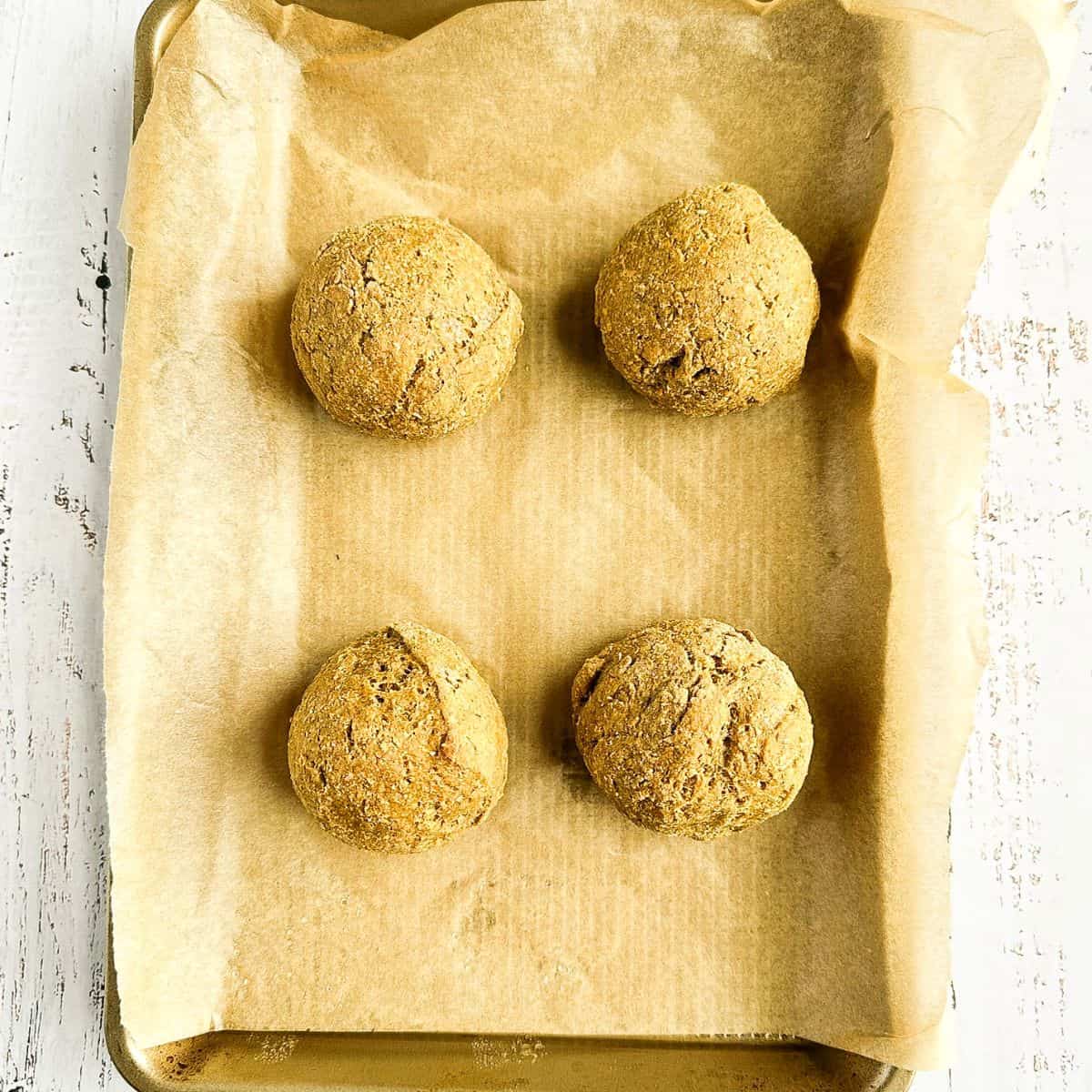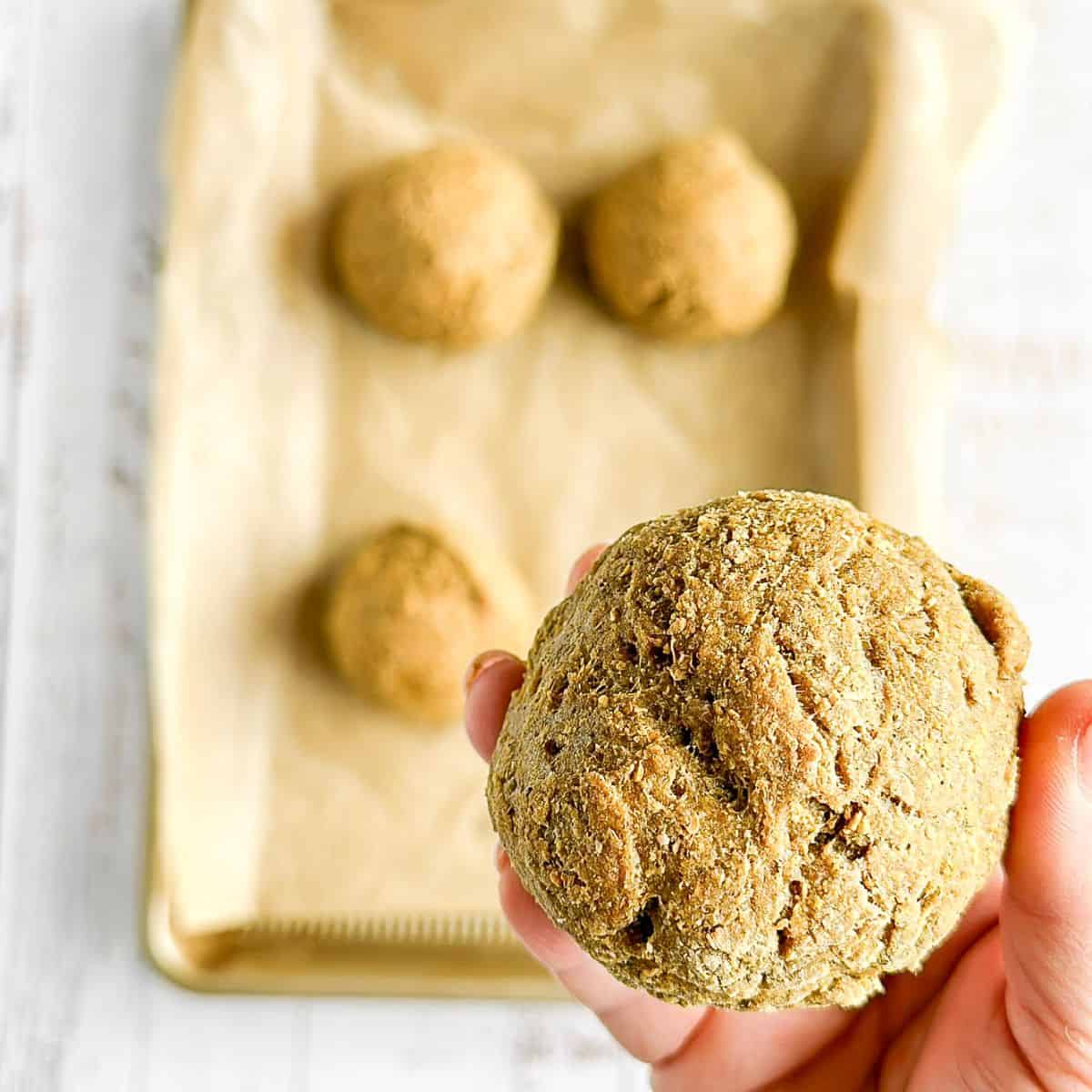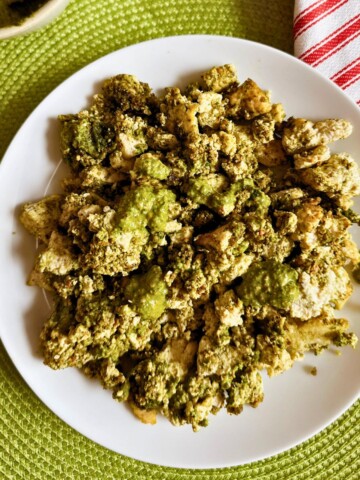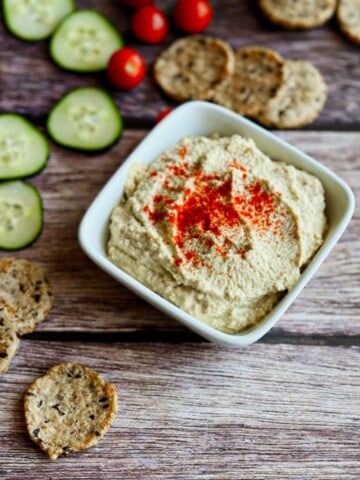Lupini beans make a great high-protein seitan and are perfect for those looking to make a homemade, meat-free alternative high in protein and low in fat and carbs.
Don't know about lupini beans? Check out All About Lupini Beans to learn more.

Are you looking to up your plant-based protein? You got it - High Protein Lupini Bean Seitan!
This homemade meat alternative is high in protein but also versatile, easy to make, quick to make, and great for meal planning high-protein meals. You can add this lupini bean seitan to High-Protein Tofu Scramble.
Credit for this lupini seitan recipe goes to Natalie Mathews, whose original recipe can be found on her website, Fit Vegan Chef. If you visit her site, you will find other great high-protein recipes.
Jump to:
What Is Seitan?
Seitan is a plant-based protein source made from wheat gluten. It has a meat-like texture and is often used as a meat substitute in vegetarian and vegan dishes. It is also known as wheat meat or mock meat.
Ingredients
I have often made homemade seitan and those recipes were delicious but time-consuming and more complicated. This seitan comes together quickly, and it is super high in protein. Here are the ingredients. See the recipe card for quantities.

The keys to making this a super high-protein recipe are the lupini beans, nutritional yeast, and vital wheat gluten.

- Lupini beans are a type of legume consumed for centuries in the Mediterranean region, South America, and parts of Africa. They are high in protein and low in carbohydrates and fat. Buying ready-to-eat lupini beans is the easiest option because dried lupini beans require soaking in water for several days to remove their bitter taste and soften their tough outer skins. I buy the sea salt and vinegar variety of Brami Lupini Beans on Amazon.
- Vital Wheat Gluten: Manufacturers make vital wheat gluten by removing the starch from wheat, leaving behind the natural protein in wheat, resulting in a high-protein flour. The protein content of vital wheat gluten can vary slightly depending on the brand and the processing method. Still, on average, it contains about 75-80% protein.
- Liquid aminos add a savory and umami flavor. In addition to adding flavor, liquid aminos can help tenderize the seitan. Substitute with soy sauce or tamari.
- Nutritional yeast has a slightly nutty, cheesy, and savory flavor, adding depth and richness to this seitan recipe. It also balances out any bitterness in vital wheat gluten and is rich in protein and B vitamins.
How To Make High-Protein Lupini Bean Seitan
What I like about this recipe the most is how easy it is to make homemade, baked seitan at home. Here are the highlights. See the recipe card for details.

Step 1: Start with by putting the lupini beans in the food processor.

Step 2: Place the remaining wet ingredients. Set aside.

Step 3: In a large bowl, combine the dry ingredients - vital wheat gluten, nutritional yeast, and Vegan Chicken Seasoning or other seasonings.

Step 4: Place the wet ingredients from the blender into the dry ingredients.

Step 5: It's easiest with your hands.

Step 6: Mix well until combined but do not over mix as this will create a dense seitan.

Step 7: Weigh the dough and separate it into 4 equal parts. You can shape the seitan into balls, sausages, or patties if you would like.

Step 8: Place the seitan on a baking tray with parchment paper

Step 9: Bake covered with aluminum foil for 20 minutes

Step 10: Remove the foil and bake for an additional 35 minutes.

Step 11: Let it cool before slicing.
What Are The Benefits Of High-Protein Seitan?
- The estimated macros for one serving of this homemade recipe are 31g protein/11g carbs/1g fat, making a great protein for those seeking high protein but low carb and fat sources.
- You can use high-protein lupini bean seitan in various recipes, including stir-fries, sandwiches, and even as a pizza topping.
- This recipe is easy to make at home.
- It's baked seitan with no oil in the ingredients.
- Seitan is generally an environmentally friendly protein source, requiring less water and land than animal-based protein sources.

How To Use High-Protein Seitan
You can use this versatile high-protein seitan in a variety of plant-based dishes. Try these ideas:
- Add to your favorite stir-fry recipe for a protein boost.
- Eat it in a Buddha bowl. I love my seitan sliced in a Buddha bowl with iceberg lettuce, edamame, rice, and broccoli topped with Vegan Ranch, Simple Thai Peanut Sauce, Vegan Honey Mustard Dressing, High-Protein Vegan Caesar Dressing Recipe, or Vegan Yum Yum Sauce.
- You can slice or shred this seitan and use it in sandwiches or wraps - it's delicious either way! Add some avocado, lettuce, tomato, and vegan mayo for a delicious and filling sandwich.
- Roll the seitan to form sausage shapes. Grill or pan-fry until crispy and serve with sauerkraut and mustard for a vegan take on classic sausage and sauerkraut.
- Vary the spices and use this seitan as a filling for tacos or burritos, along with your choice of beans, rice, and vegetables.
- Use on a salad for an extra protein boost.
- Use thin slices as a pizza topping for a meat-free alternative.

Top Tips
- Keep from over-mixing the dough. Over-mixing can cause the gluten to become over-developed, resulting in a dense and chewy texture that is unpleasant to eat.
- Add your favorite seasonings. The seasonings provided in the recipe are just one way to season the seitan. Use Italian Seasoning, Cajun Seasoning, or Homemade Taco Seasoning for variety.
- If you find the seitan too dense for your taste, I have succeeded with a moist version by boiling the seitan balls in water or steaming them wrapped in foil for around 30 minutes. It will be soft when you take it out. Then place in a 350°F oven until golden brown (about 40 minutes).

Seitan FAQS
No, seitan is made from wheat gluten, which is unsuitable for those with gluten allergies or sensitivities.
Yes, it can be frozen for up to three months. Wrap it tightly in plastic wrap and place it in the freezer. When you are ready to eat, let it defrost in the refrigerator or on the counter for several hours.
Store in an air-tight container in the fridge for up to a week.
This seitan is a healthier alternative to meat because it is low in fat and cholesterol. It is also an environmentally friendly option.
More Delicious Protein-Rich Recipes
Have a minute? I'd love for you to read the comments and rate this High-Protein Lupini Bean Seitan. Your feedback is invaluable—did you love it? Did you make any fun twists? Let me know how my directions worked for you so I can keep improving my recipes. For inspiration, follow me on Pinterest, Instagram, Facebook, and YouTube for inspiration.

High Protein Lupini Bean Seitan
Ingredients
- 150 grams lupini beans a bag of Brami beans
- 6 ounces water
- ½ tablespoon liquid aminos or soy sauce or tamari
- 2 teaspoon liquid smoke
- 120 grams vital wheat gluten
- 20 grams nutritional yeast
- 1 tablespoon poultry seasoning or any mixed seasoning you enjoy
- ¼ teaspoon adobo or garlic salt
Instructions
- Preheat: Heat the oven to 350°F and prepare a pan with parchment paper or a silicone mat.
- Blend: In a blender, mix together the lupini beans, water, liquid aminos, and liquid smoke.
- Combine: In a large bowl, combine the wheat gluten, nutritional yeast, seasoning, and adobo or garlic salt.
- Incorporate: Add the wet and dry ingredients and mix until a dough forms.
- Knead: Knead the dough until well combined, but do not over-mix.
- Divide: Weigh the dough and divide it into four equal portions. Cut the dough into pieces and shape them into your desired size and shape.
- Bake: Add the seitan to the oven covered with aluminum foil for 20 minutes.
- Finish: Remove the aluminum foil and bake an additional 35 minutes.
- Cool: Remove the seitan from the oven and let cool before slicing.










Diane P says
Do you remove the skins from the lupini beans before adding them to the food processor? Thanks! 🙂
Regi Pearce says
Hey Diane! If you’re using the ready-to-eat lupini beans from Brami, you don’t need to remove the skins. They blend up just fine and add extra fiber. But if you’re using fresh or dried lupini beans that you’ve cooked yourself, the skins can be a bit tough and bitter, so peeling may be better. It's up to you though. Just know that the skin is edible. Hope this helps and let me know if you need anything else.
Regi Pearce says
The lupini beans add great texture and extra protein boost, making seitan even more satisfying. It’s firm, chewy, and perfect for slicing into sandwiches, stir-fries, or grilling. Plus, it holds up so well in marinades! My new favorite way to make an easy homemade seitan.
Madison says
Soooo good!
Regi Pearce says
Thrilled to hear you found the lupini seitan 'soooo good!' Thanks for trying the recipe and for sharing your excitement!